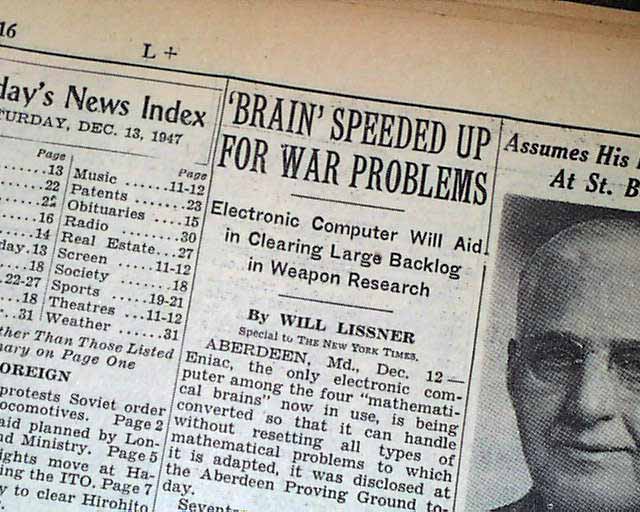Early computer invention ENIAC...
Item # 590097
THE NEW YORK TIMES, December 13, 1947
* Eniac 1 invention (early computer)
* 1st electronic computer
* Aberdeen Proving Ground
This 32 page newspaper has one column headlines on page 16: "'BRAIN' SPEEDED UP FOR WAR PROBLEMS" and "Electronic Computer Will Aid in Clearing Large Backlog in Weapon Research". See photos for text.
Other news, sport and advertisements of the day throughout. A little spine wear, otherwise nice condition.
wikipedia notes: ENIAC, short for Electronic Numerical Integrator And Computer,[1] was the first general-purpose electronic computer. Precisely, it was the first high-speed, purely electronic, Turing-complete, digital computer capable of being reprogrammed to solve a full range of computing problems,[2] since earlier machines had been built with some of these properties. ENIAC was designed and built to calculate artillery firing tables for the U.S. Army's Ballistic Research Laboratory.
The contract was signed on June 5, 1943 and Project PX was constructed by the University of Pennsylvania's Moore School of Electrical Engineering from July, 1943. It was unveiled on February 14, 1946 at Penn, having cost almost $500,000. ENIAC was shut down on November 9, 1946 for a refurbishment and a memory upgrade, and was transferred to Aberdeen Proving Ground, Maryland in 1947. There, on July 29 of that year, it was turned on and would be in continuous operation until 11:45 p.m. on October 2, 1955.
ENIAC was conceived and designed by John Mauchly and J. Presper Eckert of the University of Pennsylvania.[3] The team of design engineers assisting the development included Bob Shaw (function tables), Chuan Chu (divider/square-rooter), Kite Sharpless (master programmer), Arthur Burks (multiplier), Harry Huskey (reader/printer), and Jack Davis (accumulators).
Category: The 20th Century
















